NCERT Solutions for Class 10 Science Chapter 9 - Light Reflection and Refraction
| Table of contents |

|
| Page No. 145 |

|
| Page No. 150 |

|
| Page No. 158 |

|
| Page No. 159 |

|
| Page No. 160 |

|
Page No. 142
Q1. Define the principal focus of a concave mirror.
Ans: Light rays that are parallel to the principal axis of a concave mirror converge at a specific point on its principal axis after reflecting from the mirror. This point is known as the principal focus of the concave mirror.
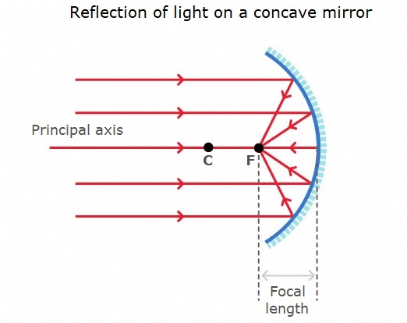
Q2. The radius of curvature of a spherical mirror is 20 cm. What is its focal length?
Ans: Radius of curvature, R = 20 cm.
The radius of curvature of a spherical mirror = 2 × Focal length (f) i.e. R = 2 f

Hence, the focal length of the given spherical mirror is 10 cm.
Q3. Name the mirror that can give an erect and enlarged image of an object.
Ans: When an object is placed between the pole and the principal focus of a concave mirror, the image formed is virtual, erect, and enlarged. Therefore, the mirror is concave.
Q4. Why do we prefer a convex mirror as a rear-view mirror in vehicles?
 Ans: Convex mirrors give a virtual, erect, and diminished image of the objects placed in front of them. They are preferred as a rear-view mirror in vehicles because they give a wider field of view, which allows the driver to see most of the traffic behind him.
Ans: Convex mirrors give a virtual, erect, and diminished image of the objects placed in front of them. They are preferred as a rear-view mirror in vehicles because they give a wider field of view, which allows the driver to see most of the traffic behind him.
Page No. 145
Q1. Find the focal length of a convex mirror whose radius of curvature is 32 cm.
Ans: Radius of curvature, R = 32 cm
Radius of curvature = 2 × Focal length ( f ) i.e. R = 2 f

Hence, the focal length of the given convex mirror is 16 cm.
Q2. A concave mirror produces three times magnified (enlarged) real image of an object placed at 10 cm in front of it. Where is the image located?
Ans: Magnification produced by a spherical mirror is given by the relation,

Let the height of the object, ho = h
Then, height of the image, hi = −3h (Image formed is real)

∵ Object distance, u = −10 cm ⇒ v = 3 × (−10) = −30 cm
Here, the negative sign indicates that an inverted image is formed at a distance of 30 cm in front of the given concave mirror.
Page No. 150
Q1. A ray of light travelling in the air enters obliquely into water. Does the light ray bend towards the normal or away from the normal? Why?
Ans: The light ray bends towards the normal. When a ray of light travels from an optically rarer medium to an optically denser medium, it gets bent towards the normal. Since water is optically denser than air, a ray of light travelling from air into the water will bend towards the normal.
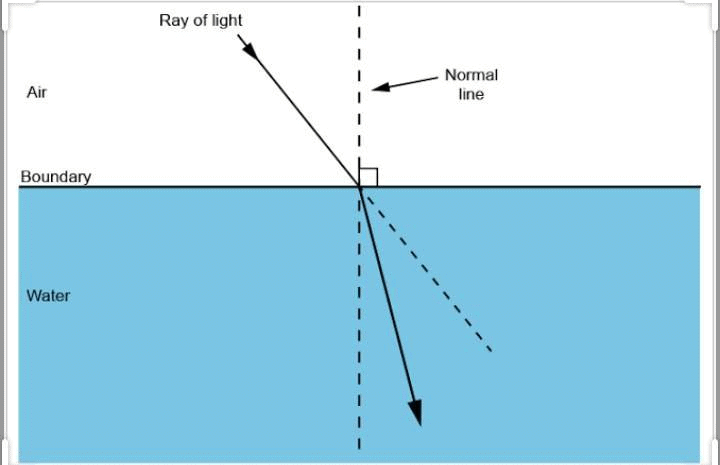
Q2. Light enters from air to glass having a refractive index of 1.50. What is the speed of light in the glass? The speed of light in a vacuum is 3 × 108 ms−1.
Ans: Refractive index of a medium nm is given by,

Speed of light in vacuum, c = 3 × 108 m s−1
Refractive index of glass, ng = 1.50
 Q3. Find out, from Table, the medium having the highest optical density. Also, find the medium with the lowest optical density.
Q3. Find out, from Table, the medium having the highest optical density. Also, find the medium with the lowest optical density. 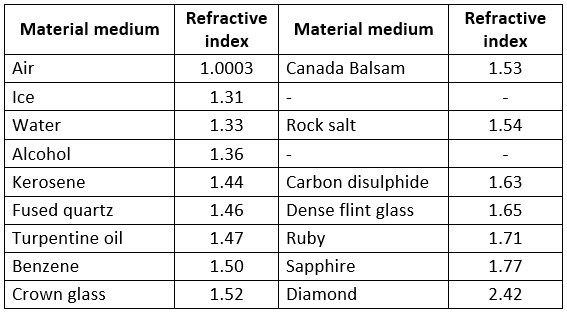
Ans: Highest optical density = Diamond, Lowest optical density = Air
- The optical density of a medium is directly related to the refractive index of that medium. A medium that has the highest refractive index will have the highest optical density and vice-versa.
- It can be observed from the table that diamond and air respectively have the highest and lowest refractive index. Therefore, diamond has the highest optical density and air has the lowest optical density.
Q4. You are given kerosene, turpentine and water. In which of these does the light travel fastest? Use the information given in Table.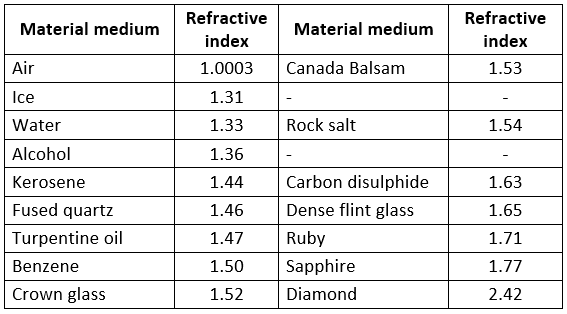
Ans: The speed of light in a medium is given by the relation for refractive index (nm).
The relation is given as:

It can be inferred from the relation that light will travel the slowest in the material which has the highest refractive index and travel the fastest in the material which has the lowest refractive index.
It can be observed from table 10.3 that the refractive indices of kerosene, turpentine, and water are 1.44, 1.47, and 1.33 respectively. Therefore, light travels the fastest in water.
Q5. The refractive index of diamond is 2.42. What is the meaning of this statement?
Ans: The Refractive index of a medium nm is related to the speed of light in that medium v by the relation:

Where c is the speed of light in vaccum/air.
The refractive index of diamond is 2.42. This suggests that the speed of light in a diamond will reduce by a factor of 2.42 compared to its speed in air.
Page No. 158
Q1. Define 1 dioptre of power of a lens.
Ans: The power of the lens is defined as the reciprocal of its focal length. If P is the power of a lens of focal length f in metres, then
P = 1 / f(in metres)
The S.I. unit of power of a lens is Dioptre. It is denoted by D.
1 dioptre is defined as the power of a lens of focal length 1 metre i.e. 1 D = 1 m−1.
Q2. A convex lens forms a real and inverted image of a needle at a distance of 50 cm from it. Where is the needle placed in front of the convex lens if the image is equal to the size of the object? Also, find the power of the lens.
Ans: When an object is placed at the centre of curvature, 2F1, of a convex lens, its image is formed at the centre of curvature, 2F2, on the other side of the lens. The image formed is inverted and of the same size as the object, as shown in the given figure.
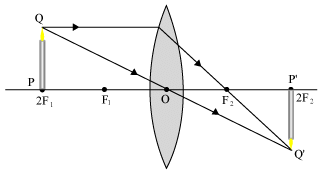
It is given that the image of the needle is formed at a distance of 50 cm from the convex lens.
Hence, the needle is placed in front of the lens at a distance of 50 cm.
Object distance, u = −50 cm, Image distance, v = 50 cm
According to the lens formula,
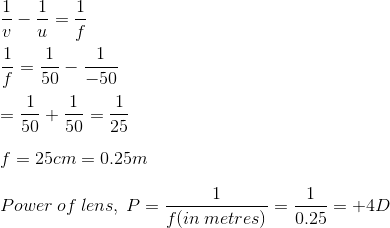
Hence, the power of the given lens is +4 D.
Q3. Find the power of a concave lens of focal length 2 m.
Ans: Focal length of a concave lens, f=−2m (negative due to the divergent nature of the concave lens)
Power of a lens, 
Hence, the power of the given concave lens is −0.5D.
Page No. 159
Exercises
Q1. Which one of the following materials cannot be used to make a lens?
(a) Water
(b) Glass
(c) Plastic
(d) Clay
Ans: (d)
Explanation: A lens allows light to pass through it. Since clay does not show such property, it cannot be used to make a lens.
Q2. The image formed by a concave mirror is observed to be virtual, erect and larger than the object. Where should be the position of the object?
(a) Between the principal focus and the centre of curvature
(b) At the centre of curvature
(c) Beyond the centre of curvature
(d) Between the pole of the mirror and its principal focus
Ans: (d)
Explanation: When an object is placed between the pole and principal focus of a concave mirror, the image formed is virtual, erect, and larger than the object.
Q3. Where should an object be placed in front of a convex lens to get a real image of the size of the object?
(a) At the principal focus of the lens
(b) At twice the focal length
(c) At infinity
(d) Between the optical centre of the lens and its principal focus.
Ans: (b)
Explanation: When an object is placed at the centre of curvature in front of a convex lens, its image is formed at the centre of curvature on the other side of the lens. The image formed is real, inverted, and of the same size as the object.
Q4. A spherical mirror and a thin spherical lens have each a focal length of −15 cm. The mirror and the lens are likely to be
(a) both concave
(b) both convex
(c) the mirror is concave and the lens is convex
(d) the mirror is convex, but the lens is concave
Ans: (a)
Explanation: By convention, the focal length of a concave mirror and a concave lens are taken as negative. Hence, both the spherical mirror and the thin spherical lens are concave in nature.
Page No. 160
Q5. No matter how far you stand from a mirror, your image appears erect. The mirror is likely to be
(a) plane
(b) concave
(c) convex
(d) either plane or convex
Ans: (d)
Explanation: A convex mirror always gives a virtual and erect image of the smaller size of the object placed in front of it. Similarly, a plane mirror will always give a virtual and erect image of same size as that of the object placed in front of it. Therefore, the given mirror could be either plane or convex.
Q6. Which of the following lenses would you prefer to use while reading small letters found in a dictionary?
(a) A convex lens of focal length 50 cm
(b) A concave lens of focal length 50 cm
(c) A convex lens of focal length 5 cm
(d) A concave lens of focal length 5 cm
Ans: (c)
Explanation: A convex lens gives a magnified image of an object when it is placed between the radius of curvature and focal length. Also, magnification is more for convex lenses having a shorter focal length. Therefore, for reading small letters, a convex lens of focal length 5 cm should be used.
Q7. We wish to obtain an erect image of an object, using a concave mirror of focal length 15 cm. What should be the range of distance of the object from the mirror? What is the nature of the image? Is the image larger or smaller than the object? Draw a ray diagram to show the image formation in this case.
Ans: Range of object distance = 0 cm to 15 cm
A concave mirror gives an erect image when an object is placed between its pole (P) and the principal focus (F).
Hence, to obtain an erect image of an object from a concave mirror of focal length 15 cm, the object must be placed anywhere between the pole and the focus. The image formed will be virtual, erect, and magnified in nature, as shown in the given figure.
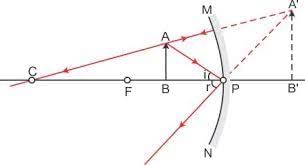
Q8. Name the type of mirror used in the following situations.
(a) Headlights of a car
(b) Side/rear-view mirror of a vehicle
(c) Solar furnace
Support your answer with reason.
Ans:
(a) Concave
(b) Convex
(c) Concave
Explanation:(a) Concave mirror is used in the headlights of a car. This is because concave mirrors can produce a powerful parallel beam of light when the light source is placed at their principal focus.
(b) Convex mirror is used inside/rearview mirror of a vehicle. Convex mirrors give a virtual, erect, and diminished image of the objects placed in front of it. Because of this, they have a wide field of view. It enables the driver to see most of the traffic behind him/her.
(c) Concave mirrors are convergent mirrors. That is why they are used to construct solar furnaces. Concave mirrors converge the light incident on them at a single point known as the principal focus. Hence, they can be used to produce a large amount of heat at that point.
Q9. One-half of a convex lens is covered with black paper. Will this lens produce a complete image of the object? Verify your answer experimentally. Explain your observations.
Ans: The convex lens will form a complete image of an object, even if its one half is covered with black paper. It can be understood by the following two cases.
Case I:
When the upper half of the lens is covered
In this case, a ray of light coming from the object will be refracted by the lower half of the lens. These rays meet at the other side of the lens to form the image of the given object, as shown in the following figure.
Case II:
When the lower half of the lens is covered
In this case, a ray of light coming from the object is refracted by the upper half of the lens. These rays meet at the other side of the lens to form the image of the given object, as shown in the following figure.
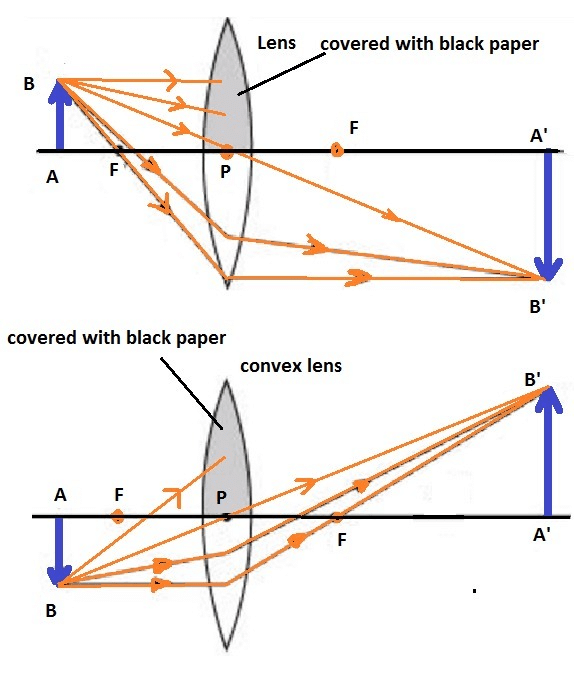
Q10. An object 5 cm in length is held 25 cm away from a converging lens of focal length 10 cm. Draw the ray diagram and find the position, size and nature of the image formed.
Ans: We know that a converging lens forms the image of an object placed in front of it by converging the light rays falling on it. We can find the image distance very easily using the lens’ formula when the focal length and the object distance of the system is given
According to the lens’ formula –
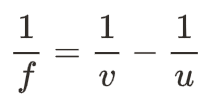
Where, f is the focal length of the lens,
v is the image distance,
u is the object distance.
It is given that the object is 25 cm away from the lens and the focal length of the lens is 10 cm. We can find the image distance by substituting the values as –
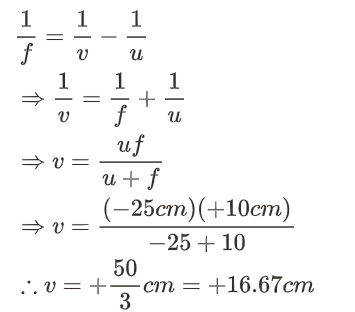
We can find the magnification of the image formed by finding the ratio between the image distance to the object distance. This is given by –

From this we can conclude that the image is two-third of the object size. The image size can be given as –
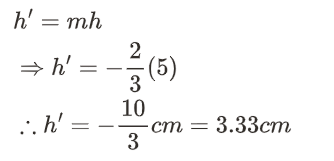
The image size has a negative sign, this implies that the image formed is real and inverted

The image is formed 16.67 cm away from the lens. The image size is 3.33 cm. The image is real and inverted.
Q11. A concave lens of focal length 15 cm forms an image 10 cm from the lens. How far is the object placed from the lens? Draw the ray diagram.
Ans: Since the focal length of a concave lens is negative
∴ Focal length = f = –15 cm
Also,
A concave lens forms a virtual, erect image
Hence, image distance will be negative
Image distance = v = –10 cm
Let the object distance = u
Using lens formula,
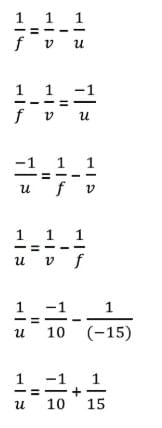
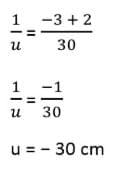
Hence, object is placed 30 cm in front of the lens.
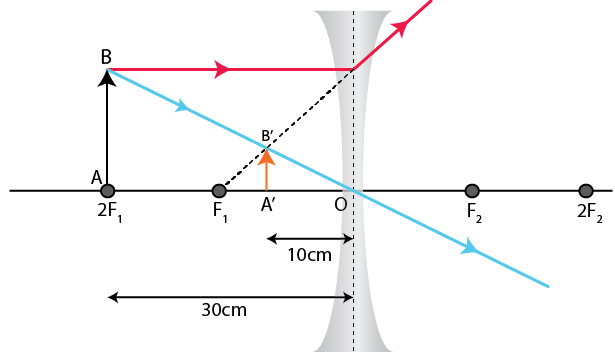
Q12. An object is placed at a distance of 10 cm from a convex mirror of focal length 15 cm. Find the position and nature of the image.
Ans: Focal length of convex mirror, f = +15 cm, Object distance, u = −10 cm
- According to the mirror formula,
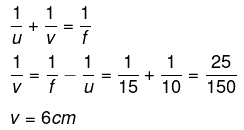
- The positive value of 'v' indicates that the image is formed behind the mirror.

The positive value of magnification indicates that the image formed is virtual and erect.
Q13. The magnification produced by a plane mirror is +1. What does this mean?
Ans: Magnification produced by a mirror is given by the relation:

The magnification produced by a plane mirror is +1. It shows that the image formed by the plane mirror is of the same size as that of the object. The positive sign shows that the image formed is virtual and erect.
Q14. An object 5.0 cm in length is placed at a distance of 20 cm in front of a convex mirror of radius of curvature 30 cm. Find the position of the image, its nature and size:
Ans. Object distance, u = −20 cm, Object height, h = 5 cm, Radius of curvature, R = 30 cm
- Radius of curvature = 2 × Focal length i.e. R = 2f
⇒ f = 15 cm - According to the mirror formula,
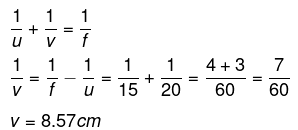
- The positive value of 'v' indicates that the image is formed behind the mirror.

- The positive value of magnification indicates that the image formed is virtual

The positive value of image height indicates that the image formed is erect.
Therefore, the image formed is virtual, erect, and smaller in size.
Q15. An object of size 7.0 cm is placed at 27 cm in front of a concave mirror of focal length 18 cm. At what distance from the mirror should a screen be placed so that a sharply focused image can be obtained? Find the size and nature of the image.
Ans: Object distance, u = −27 cm, Object height, h = 7 cm, Focal length, f = −18 cm
- According to the mirror formula,
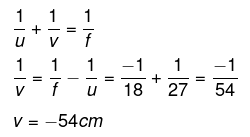
- The screen should be placed at a distance of 54 cm in front of the given mirror.

- The negative value of magnification indicates that the image formed is real.

The negative value of image height indicates that the image formed is inverted.
Q16. Find the focal length of a lens of power −2.0 D. What type of lens is this?
Ans:
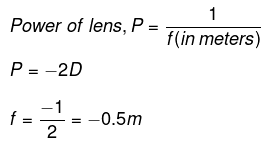
A concave lens has a negative focal length. Hence, it is a concave lens.
Q17. A doctor has prescribed a corrective lens of power +1.5 D. Find the focal length of the lens. Is the prescribed lens diverging or converging?
Ans:
|
80 videos|569 docs|80 tests
|
FAQs on NCERT Solutions for Class 10 Science Chapter 9 - Light Reflection and Refraction
| 1. What is the law of reflection? |  |
| 2. What is refraction of light? |  |
| 3. How does a concave mirror form an image? |  |
| 4. What is the difference between a convex and a concave lens? |  |
| 5. What is total internal reflection? |  |
















